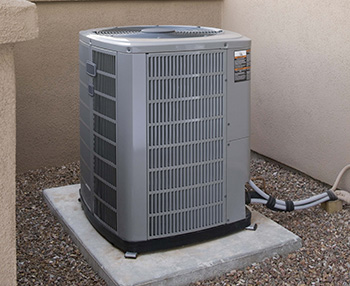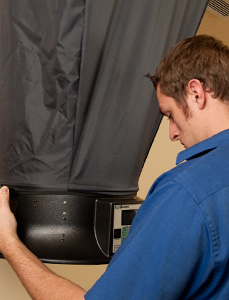When it comes to HVAC sales, things can be quite confusing. The rapid pace of technological development means that no manufacturer can maintain a competitive edge for very long. Manufacturers develop a hot new box and, before they can cash their first check, a competitor has produced a bigger, better, faster or cheaper version. As a result, when you are on a sales call, customers are more inclined to view what you’re selling as a commodity – no real difference between you and the next guy. Throw in the customer’s ability to research anything and everything on the Internet and this complicates your sales life tremendously.

HVAC sales have become “box” sales. A box is like this condensing unit.
A Box Is Just A Box
In most cases, the box you’re selling is exactly the same as your competitor’s box. I spent several years in sales for my family HVAC business. We sold, for the most part, exactly the same boxes from the same manufacturer as four or five of our local competitors. When you take the brand name out of the equation, we were selling the “same” three-ton condensing unit and 80,000-Btuh furnace as hundreds of our competitors. You work in this same type of business environment, don’t you?
Now, to be sure, our box had a few more bells and whistles when compared to some of the other boxes, but it was increasingly difficult to get the customer to understand the difference. Unfortunately, most customers view your box as a commodity with no real difference between what you sell and what your competitor sells. A three-ton system is a three-ton system is a three-ton system – isn’t it?
Think about it … How much real difference is there between the boxes out there anyway? Aren’t they all pretty much using the same scroll compressors, copper tubing, capacitors, motors, and contactors? If all you’re selling is a box, the lowest price will usually win the job. Regardless of your situation, the question is the same: How do we profitably win the sale when the customer perceives us as selling just another “me too” box?
Sell Solutions, Not Boxes
So, what do you do? To put it simply, when on a sales call, you must detail and communicate the important ways that your “solution” differs from your competitor’s. I use the word “solution” to include every aspect of your offering – not just the box. You need to skillfully put the box in its rightful place and prove to the customer that your solution is much more than just a box. That’s easier said than done. To do so effectively, you need to invest concentrated time thinking, planning, preparing, practicing and measuring. You must carefully consider the two most important elements of all sales – your customer and your solution.
Unique Sales Solutions Required
Granted, your box may be exactly the same as the competition’s, but your sales solution can and should be dramatically different. When defining your company’s solutions, consider each of the following questions:
- What problems do your customers face?
- How do you diagnose the root cause of their problems?
- How do you design solutions to solve their problems?
- How do your solutions address their problems?
- What products, services, warranties and guarantees does your solution include?
- What types of air distribution system renovation services do you offer?
- Is your solution truly better than your competitors? How much better? Can you prove it? Will your customers testify to that fact? Do your employees believe it?
- Do you bundle your products and services to simplify investment decisions?
- Are easy financing options made available?
- Is your entire team trustworthy, loyal, helpful, friendly, courteous, kind, obedient, cheerful, thrifty, brave, clean and respectful?
- Do they have a clear game plan to follow that’s designed to ensure that they deliver the ultimate customer experience?
- Do you measure your results or are you just guessing?
Your boxes are important but your people and your processes are a much more critical part of the solution you need to be selling. The boxes may be identical, but everything else about your sales solution must be different. To set yourself apart from the competition, the focus must be on your people and your processes rather than the manufacturer’s box.
What Makes You Different?
In order to compete in the me-too box-pushing environment we find ourselves in, you must learn to clearly express the main things that make your solution far superior to that of your competitor’s box. This line of thinking is equivalent to “private labeling” your systems. In my family’s business, we focused heavily on these items in our sales process:
- Training
- Certification
- Skills
- Trade Experience
- Licensing
- Insurance
- Drug Tested
- Reliability
- Referrals & Testimonials
- Customer survey
- Technical survey
- Solution design
- Upfront pricing
- Easy financing
- No Surprises Guarantee
- Solution installation
- Quality assurance
- Ongoing maintenance

In a Performance-Based Contracting business, if you don’t measure, you’re just guessing. To close more sales, you must measure. Here a technician is measuring airflow with a flow hood.
Notice that there’s no mention of the equipment manufacturer in our process. That was by design. When we focus on the box, we take the customer’s eye off what makes us unique. When we sell them on our people and our process, they’ll typically be happy with whatever box we recommend. Plus, they can’t buy our people or processes from anyone else in town but us – we’re the sole source!
Total Solutions Sell
“Intangibles” can make all the difference in sales. It’s amazing how the “intangibles” like people and process can make all the difference in your company’s success. Here’s a simple example to prove the point.
Let’s say you want to buy a new car. You have identical price quotes from two dealers. The car is the same, and the price is the same. However, one dealer is close by, the other across town. One dealer has a reputation for great customer service; the other has no such reputation. The salesperson for the first dealer is the brother of an old high-school friend, while the salesperson for the second dealer is a bit cocky and pushy. The first dealer has a clean, comfortable establishment, while the second one is cramped, cluttered and dirty. From whom do you buy your new car? (Stupid question, right?)
You would likely buy the car from the first dealer, not because of any differences in the “box” or the price, but because of differences in the total solution. Get the idea? There’s a whole lot more that goes into a customer’s investment decision than just the box or the price.
Value-Added Sales Elements
As a salesperson, your job is to identify those differences and then make sure your customer recognizes them as being unique to you. In addition, you must clearly identify those value-added elements that make your solution far superior than the competition.

